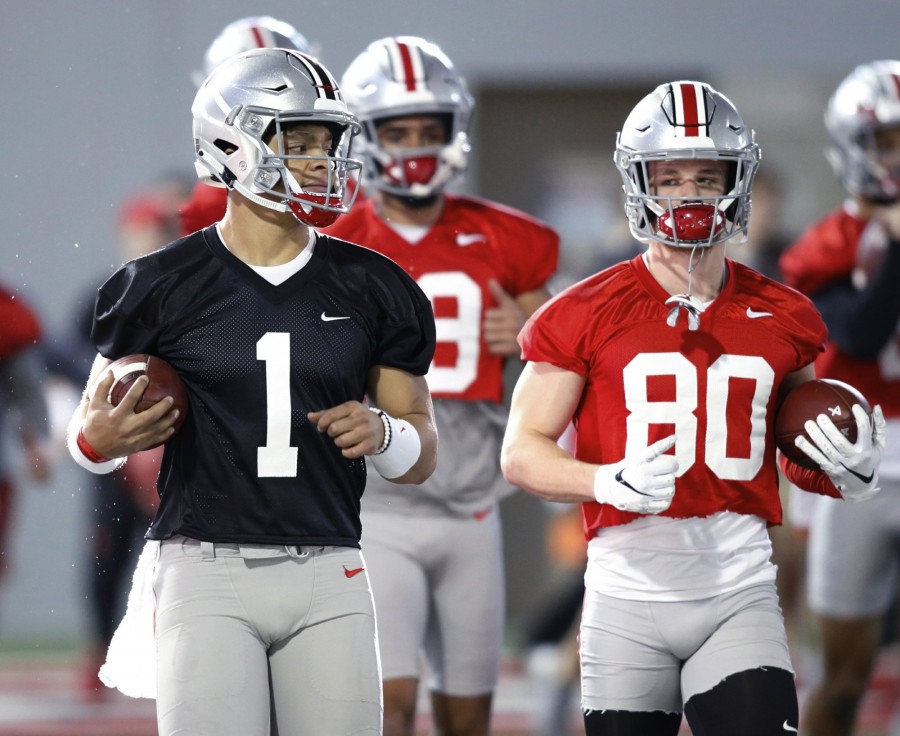A string of recent high-profile transfers gave the college football world the impression it was getting easier for players to switch schools and compete right away.
The reality is much different, with the percentage of waiver approvals dropping during 2018-2019 — even as the NCAA changed rules to give athletes a better shot at transferring without needing to sit out a year.
Shea Patterson to Michigan, Justin Fields to Ohio State and Tate Martell to Miami seemed to usher in a new era of free agency, but waiver approvals are still far from a sure thing. That is prompting athletes, coaches and others to complain about a process that can be somewhat mysterious.
Through May 24, the NCAA committee for legislative relief had approved 66% of transfer waiver requests across all sports for the 2018-19 academic year, down from 73% in the four previous years combined, according to the NCAA. In football, the transfer waiver approval rate for 2018-19 was 68%, down 2 percentage points compared with the previous four academic years.
Players frustrated by denials vent on social networks, while coaches question the NCAA's consistency. Their complaints, along with those from fans, illustrate how a dearth of public information muddles comparisons and leads onlookers to draw conclusions without knowing the full story behind each case.
"If we're going to have an ambiguous waiver system let's just either have a one-time transfer, everybody can play (immediately) and its only one time or you can transfer and you got to sit and you can get (the year of eligibility) back," Northwestern coach Pat Fitzgerald said. "One way or the other it eliminates this ambiguity that's in this waiver process."
The NCAA Division I council plans to review the rules next month.
Guidelines haven't changed for what justifies a waiver. The shift in April 2018 simply put immediate eligibility back in play for all cases. Previously, the option was tightly restricted to only instances of egregious behavior by the school the player wanted to leave.
Generally, athletes must sit out a year of competition after transferring. In many sports, a one-time exception can be used for an athlete to play right away, but not in high-profile sports such as football and basketball.
Immediate eligibility for transfers was effectively taken off the table after the 2014-15 academic year, though from 2015-18 athletes could attempt to restore a year of eligibility after switching schools. Waiver requests dipped during those three years, then bounced back in 2018-19 after the NCAA softened its rules.
The requests fall into several categories, each with specific guidelines but governed by the same basic principle: Schools have to show the transfer is because of "circumstances outside of the student-athlete's control and directly impacts the health, safety or well-being of the student-athlete," according to NCAA bylaws.
The most common waiver requests are for:
— Injury or illness to a family member
— Being pushed out of the program by a coach at the original school
— Egregious behavior by the original school
— Mental health.
Waiver requests are judged individually and subjectivity bakes into the process — which can make results seem ambiguous.
"If you get lawyers you're going to get it, but if you can't afford the lawyers, you're not," Fitzgerald said. "If somebody's sick you will, but if somebody's better you won't. If you say the coach ran you off, but he really didn't, is the coach going to come back and fight?"
Attorney Tom Mars, who has assisted Fields, Patterson and others with successful waiver requests, said ire at the NCAA over rulings might be misdirected, as individual schools are responsible for applying and presenting their cases.
"Whatever real or apparent inconsistencies there are in these waiver decisions are driven, in large part, by the varying levels of effort, resources, and quality of the advocacy that go into the preparation," Mars said. "The compliance personnel who work for the AD at those schools own the whole process."
Illinois tight end Luke Ford (from Georgia), Cincinnati offensive lineman James Hudson (from Michigan) and Virginia Tech offensive lineman Brock Hoffman (Coastal Carolina) all garnered headlines recently when the NCAA denied their waiver requests. All three new schools are currently asking for reconsideration of the ruling or appealing.
Hoffman said he was transferring to be closer to his ailing mother and the denial was based on Virginia Tech's location more than 100 miles away from his home and his mother's improving condition. Hudson said mental health issues prompted his transfer but because he did not reveal them at Michigan his request was denied.
"You can find general themes in the cases that are successful. But I also think that I understand the confusion that people are seeing out there," said attorney Travis Leach, who worked on Martell's case. "Because some cases do look similar, but when you delve into the facts and circumstances there are some nuances that make them different."
The NCAA does not comment on specific waiver cases and rarely do schools, even when an athlete waives protection under federal privacy laws.
"When appropriate, we do weigh in to educate about the process and give details we can, but we will not compromise personal information for the sake of a better headline for us," NCAA spokeswoman Emily James said.
The absence of information leads to speculation filling the void.
In Fields' case, it was reported an incident involving a Georgia baseball player directing a racial slur at him during a football game last year was part of his waiver request. But the people who know for sure what case was made on behalf of Fields have never revealed that information publicly.
Mars declined to give details but said there was more to Fields' cases than what was widely speculated.
"Time after time in the past year, I've seen college football fans accept as fact something someone else said on Twitter about the merits of a student-athlete's waiver request or the NCAA's decision to grant or deny the student-athlete a waiver," Mars said. "Despite being clueless about what the actual grounds were, or what evidence was submitted to the NCAA to support a waiver, those fans seem to uncontrollably jump to the conclusion that the NCAA made another horrible decision and start throwing rocks at the people in Indianapolis. In at least some of those cases, those angry fans might have been throwing their rocks in the wrong direction."









